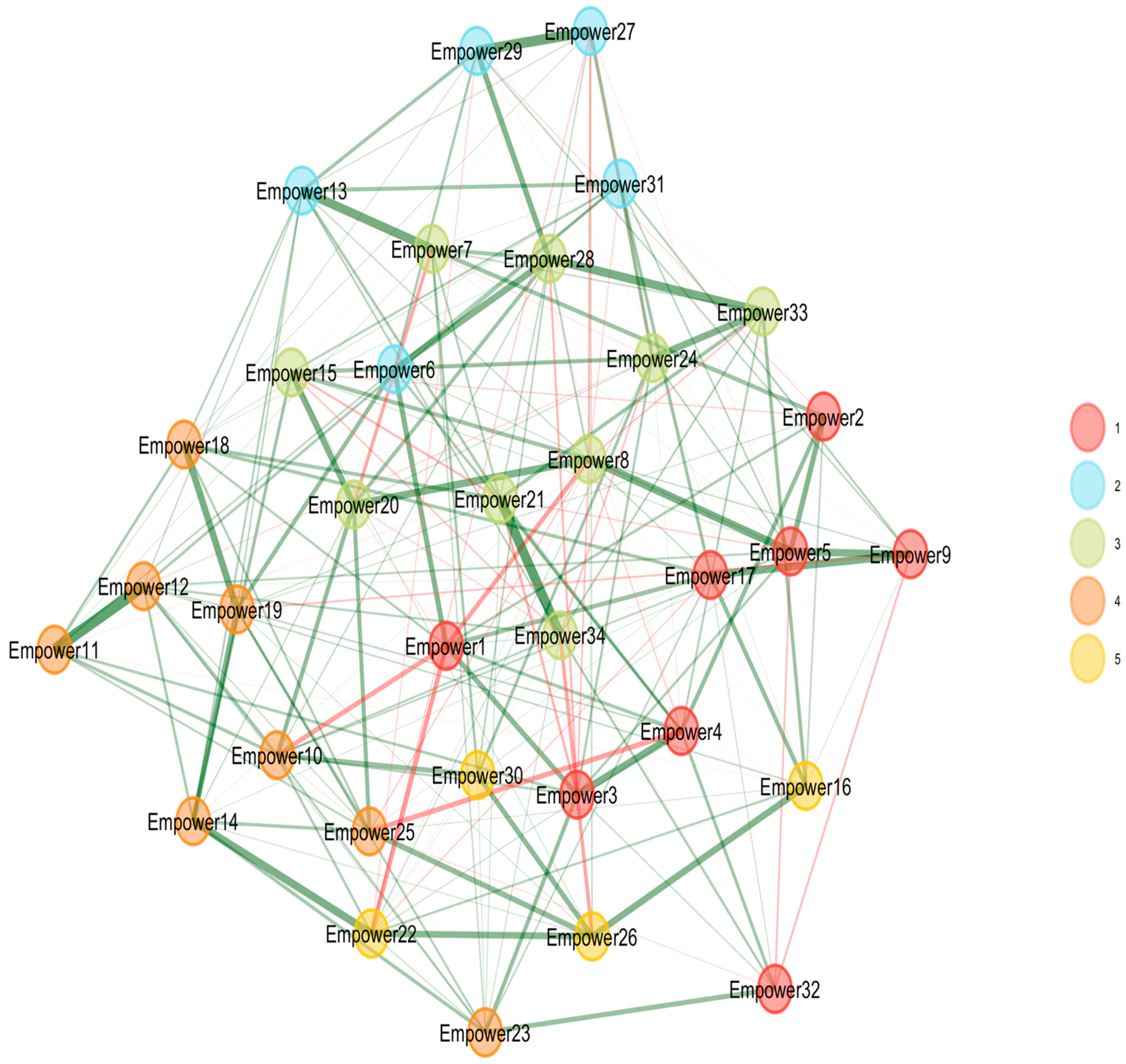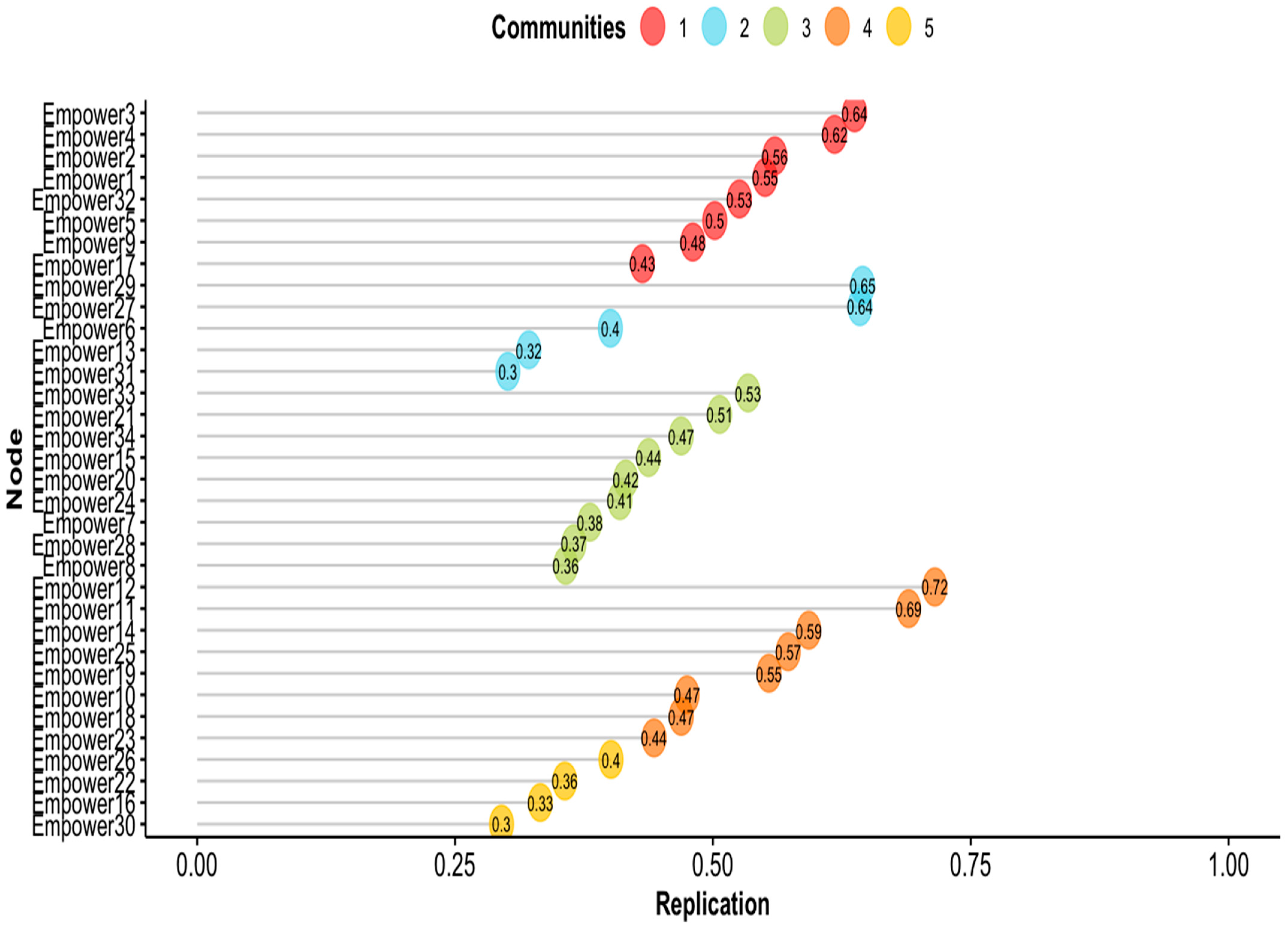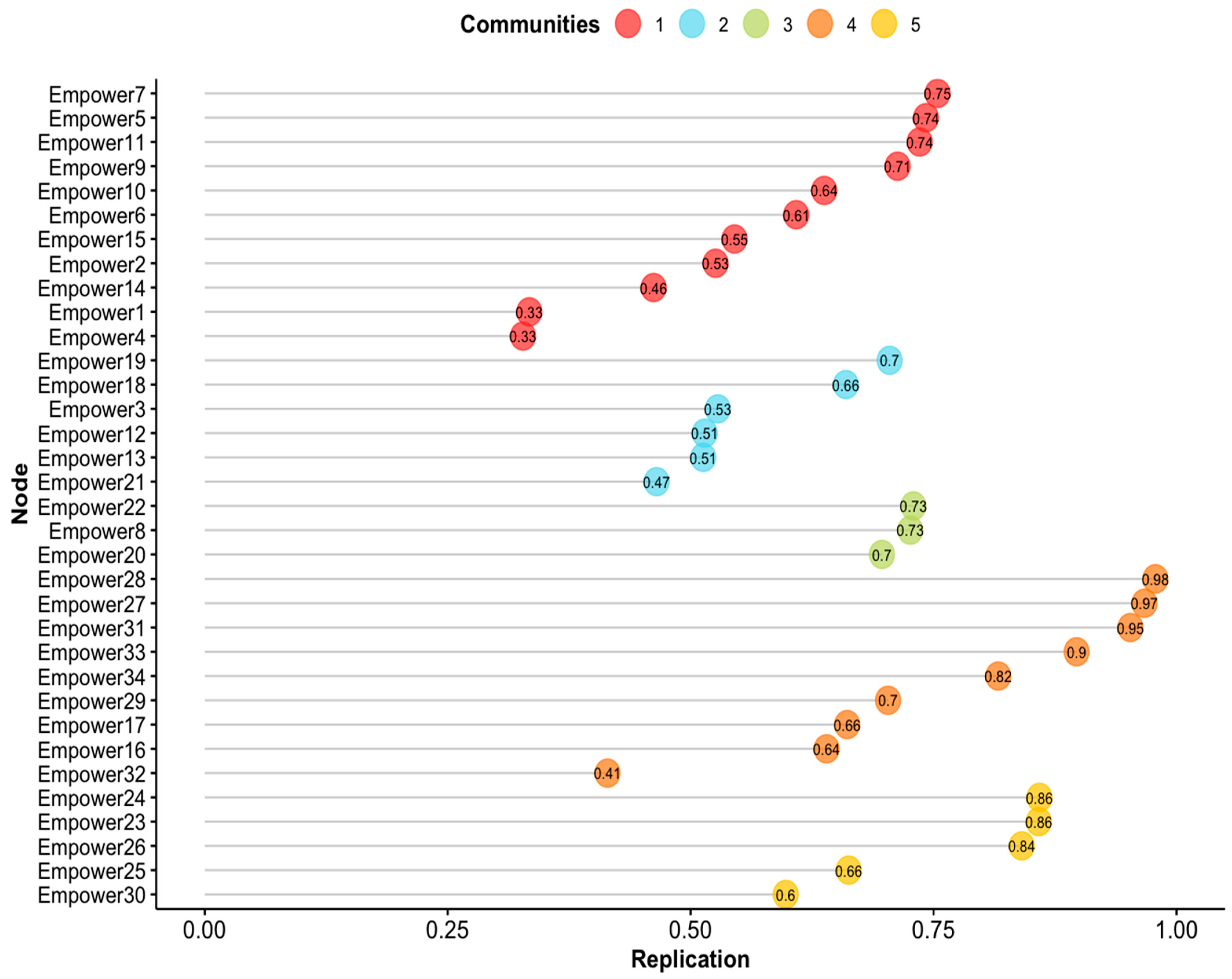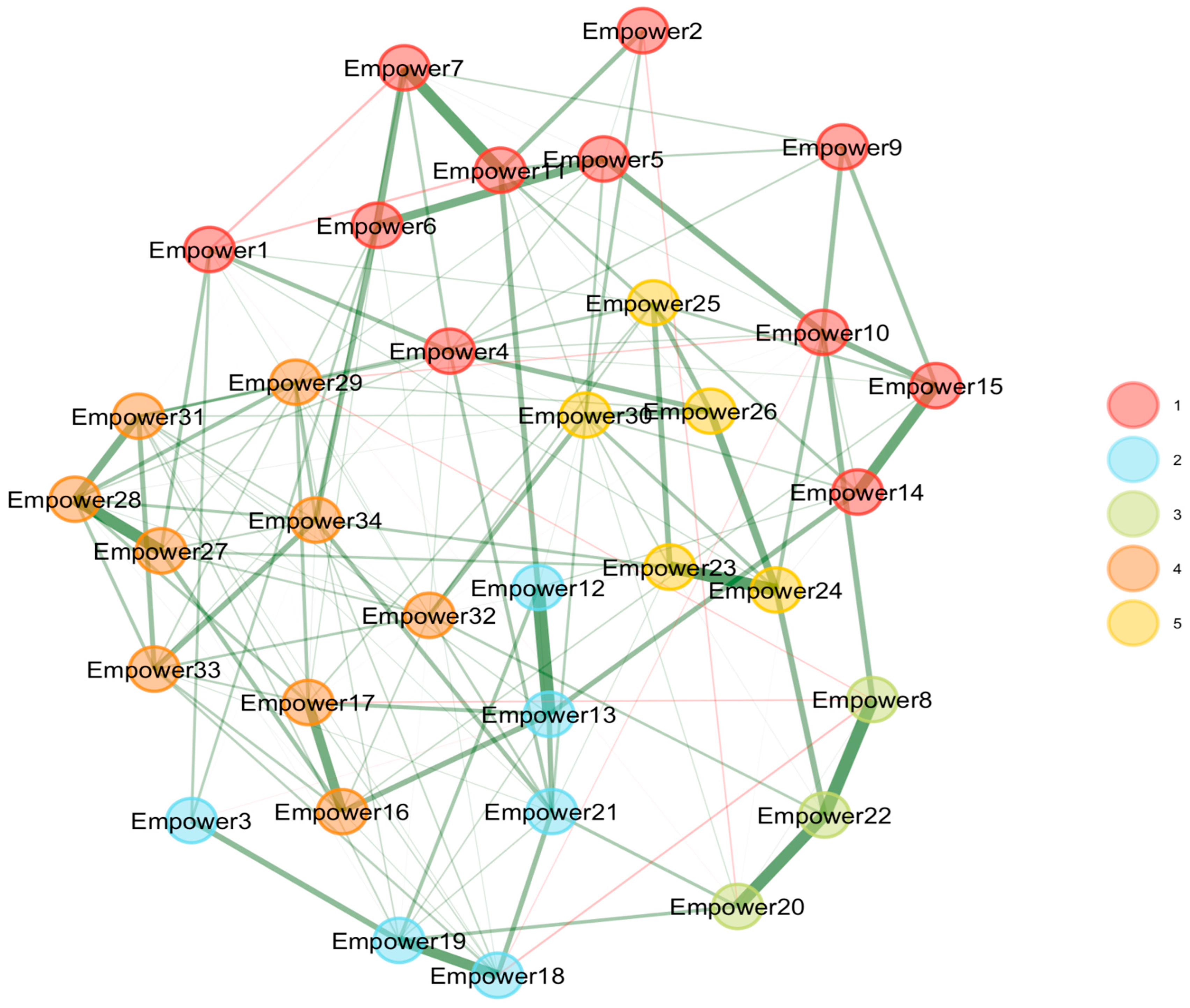Unpacking Key Dimensions of Family Empowerment Among Latinx Parents of Children with Intellectual and Developmental Disabilities Using Exploratory Graph Analysis: Preliminary Research
Abstract
1. Introduction
2. Exploratory Graph Analysis
3. Previous Research on the Family Empowerment Scale
4. Purpose of the Study
5. Methods
5.1. Sample
5.2. Measure
5.3. Data Analysis
6. Results
6.1. Descriptive Statistics
6.1.1. Empowerment for All
6.1.2. Parents of Children with Autism Based on the Original Three Dimensions of Family Empowerment and EGA-Produced Five Dimensions of Family Empowerment
6.1.3. Parents of Children with Other Disabilities Based on the Original Three Dimensions of Family Empowerment
6.2. Exploratory Graph Analysis Results for Family Empowerment for Parents of Children with Autism
6.2.1. Dimension 1: Foundational Empowerment and Advocacy Beliefs
6.2.2. Dimension 2: Relational Engagement and Supportive Parenting Practices
6.2.3. Dimension 3: Empowered Action and Collective Advocacy
6.2.4. Dimension 4: System Knowledge and Collaborative Influence
6.2.5. Dimension 5: Resource Mobilization and Policy Engagement
6.2.6. Summary of the Five Dimensions for Parents of Children with Autism
6.3. Exploratory Graph Analysis Results for Parents of Children with Other Disabilities
6.3.1. Dimension 1: Parental Confidence and Advocacy in Navigating Services
6.3.2. Dimension 2: Collaborative Empowerment in Service Decision-Making
6.3.3. Dimension 3: System-Level and Political Advocacy
6.3.4. Dimension 4: Parenting Self-Efficacy and Capacity Building
6.3.5. Dimension 5: Knowledge of Rights and Support Seeking
6.3.6. Summary of the Five Dimensions for Parents of Children with Other Disabilities
7. Discussion
7.1. Key Dimensions of Family Empowerment Scale for Parents of Children with Autism Versus Other Disabilities
7.2. Implications for Practice and Research
8. Limitations
9. Conclusions
Author Contributions
Funding
Institutional Review Board Statement
Informed Consent Statement
Data Availability Statement
Conflicts of Interest
References
- Rios, K.; Burke, M.M.; Aleman-Tovar, J. A study of the families included in Receiving Better Special Education Services (FIRME) Project for Latinx families of children with autism and developmental disabilities. J. Autism Dev. Disord. 2021, 51, 3662–3676. [Google Scholar] [CrossRef]
- Koren, P.E.; DeChillo, N.; Friesen, B.J. Measuring empowerment in families whose children have emotional disabilities: A brief questionnaire. Rehabil. Psychol. 1992, 37, 305–321. [Google Scholar] [CrossRef]
- Hayslip Jr, B.; Smith, G.C.; Montoro-Rodriguez, J.; Streider, F.H.; Merchant, W. The utility of the family empowerment scale with custodial grandmothers. J. Appl. Gerontol. 2017, 36, 320–350. [Google Scholar] [CrossRef]
- Vuorenmaa, M.; Perälä, M.L.; Halme, N.; Kaunonen, M.; Åstedt-Kurki, P. Associations between family characteristics and parental empowerment in the family, family service situations and the family service system. Child Care Health Dev. 2016, 42, 25–35. [Google Scholar] [CrossRef] [PubMed]
- Singh, N.N.; Curtis, W.; Ellis, C.; Nicholson, M.; Villani, T.; Wechsler, H. Psychometric evaluation of the Family Empowerment Scale. J. Emot. Behav. Disord. 1995, 3, 85–91. [Google Scholar] [CrossRef]
- Segers, E.W.; van den Hoogen, A.; van Eerden, I.C.; Hafsteinsdóttir, T.; Ketelaar, M. Perspectives of parents and nurses on the content validity of the Family Empowerment Scale for parents of children with a chronic condition: A mixed-methods study. Child Care Health Dev. 2019, 45, 111–120. [Google Scholar] [CrossRef]
- Kageyama, M.; Nakamura, Y.; Kobayashi, S.; Yokoyama, K. Validity and reliability of the Family Empowerment Scale for caregivers of adults with mental health issues. J. Psychiatr. Ment. Health Nurs. 2016, 23, 521–531. [Google Scholar] [CrossRef]
- Gerkensmeyer, J.E.; Perkins, S.M.; Scott, E.L.; Wu, J. Depressive symptoms among primary caregivers of children with mental health needs: Mediating and moderating variables. Arch. Psychiatr. Nurs. 2008, 22, 135–146. [Google Scholar] [CrossRef]
- Huscroft-D’Angelo, J.; January, S.A.A.; Duppong Hurley, K.L. Supporting parents and students with emotional and behavioral disorders in rural settings: Administrator perspectives. Rural Spec. Educ. Q. 2018, 37, 103–112. [Google Scholar] [CrossRef]
- Lambert, L.; Lomas, T.; van de Weijer, M.P.; Passmore, H.A.; Joshanloo, M.; Harter, J.; Ishikawa, Y.; Lai Al Kitagawa, T.; Chen, D.; Kawakami, T.; et al. Towards a greater global understanding of wellbeing: A proposal for a more inclusive measure. Int. J. Wellbeing 2020, 10. [Google Scholar] [CrossRef]
- Samuel, P.S.; Tarraf, W.; Marsack, C. Family Quality of Life Survey (FQOLS-2006): Evaluation of Internal Consistency, Construct, and Criterion Validity for Socioeconomically Disadvantaged Families. Phys. Occup. Ther. Pediatr. 2018, 38, 46–63. [Google Scholar] [CrossRef] [PubMed]
- Guerrero, F.; Zheng, Q.; Kramer, J.; Reichow, B.; Snyder, P. A systematic review of the measurement properties of the Family Empowerment Scale. Disabil. Rehabil. 2024, 46, 856–869. [Google Scholar] [CrossRef]
- Golino, H.; Epskamp, S. Exploratory graph analysis: A new approach for estimating the number of dimensions in psychological research. PLoS ONE 2017, 12, e0174035. [Google Scholar] [CrossRef]
- Golino, H.F.; Shi, D.; Christensen, A.P.; Garrido, L.E.; Nieto, M.D.; Sadana, R.; Thiyagarajan, J.A. Investigating the performance of exploratory graph analysis and traditional techniques to identify the number of latent factors: A simulation and tutorial. Psychol. Methods 2020, 25, 292–320. [Google Scholar] [CrossRef]
- Golino, H.F.; Demetriou, A. Estimating the dimensionality of intelligence like data using exploratory graph analysis. Intelligence 2017, 62, 54–70. [Google Scholar] [CrossRef]
- Christensen, A.P.; Golino, H.F.; Silvia, P.J. A psychometric network perspective on the validity and validation of personality trait questionnaires. Eur. J. Personal. 2020, 34, 1095–1108. [Google Scholar] [CrossRef]
- Golino, H.F.; Levin, M.E.; Christensen, A.P. Confirmatory network analysis: Testing network structure hypotheses. Multivar. Behav. Res. 2021, 56, 572–600. [Google Scholar]
- Golino, H.; Lillard, A.S.; Becker, I.; Christensen, A.P. Investigating the Structure of the Children’s Concentration and Empathy Scale Using Exploratory Graph Analysis. Psychol. Test Adapt. Dev. 2021, 2, 35–49. [Google Scholar] [CrossRef]
- Lee, C.; Park, Y.-H.; Cho, B. Use of Exploratory Graph Analysis in Inspecting the Dimensionality of the Revised University of California Los Angeles (R-UCLA) Loneliness Scale Among Older Adults. Res. Gerontol. Nurs. 2023, 16, 15–20. [Google Scholar] [CrossRef] [PubMed]
- Belvederi Murri, M.; Caruso, R.; Ounalli, H.; Zerbinati, L.; Berretti, E.; Costa, S.; Recla, E.; Folesani, F.; Kissane, D.; Nanni, M.G.; et al. The relationship between demoralization and depressive symptoms among patients from the general hospital: Network and exploratory graph analysis. J. Affect. Disord. 2020, 276, 137–146. [Google Scholar] [CrossRef] [PubMed]
- Boztepe, H.; Çınar, S.; Kanbay, Y.; Acımış, B.; Özgür, F.; Terzioglu, F. Validity and reliability of the Family Empowerment Scale for parents of children with cleft lip and/or palate. Child Care Health Dev. 2022, 48, 277–285. [Google Scholar] [CrossRef]
- Reise, S.P.; Morizot, J.; Hays, R.D. The Role of the Bifactor Model in Resolving Dimensionality Issues in Health Outcomes Measures. Qual. Life Res. 2007, 16, 19–31. [Google Scholar] [CrossRef]
- Jorgensen, T.D.; Pornprasertmanit, S.; Schoemann, A.M.; Rosseel, Y. Semtools: Useful Tools for Structural Equation Modeling. R Package Version 0.5-7. 2025. Available online: https://CRAN.R-project.org/package=semTools (accessed on 1 March 2025).
- Canino, G.; Vila, D.; Normand, S.L.T.; Acosta-Pérez, E.; Ramírez, R.; García, P.; Rand, C. Reducing asthma health disparities in poor Puerto Rican children: The effectiveness of a culturally tailored family intervention. J. Allergy Clin. Immunol. 2008, 121, 665–670. [Google Scholar] [CrossRef] [PubMed]
- R Core Team. R: A Language and Environment for Statistical Computing; R Foundation for Statistical Computing: Vienna, Austria, 2024; Available online: https://www.R-project.org/ (accessed on 1 January 2025).
- Golino, H.; Christensen, A.P. EGAnet: Exploratory Graph Analysis—A Framework for Estimating the Number of Dimensions in Multivariate Data Using Network Psychometrics [R Package], version 2.3.0; R Pakage: Madison, WI, USA, 2025. [CrossRef]
- Christensen, A.P.; Golino, H. Estimating the Stability of Psychological Dimensions via Bootstrap Exploratory Graph Analysis: A Monte Carlo Simulation and Tutorial. Psych 2021, 3, 479–500. [Google Scholar] [CrossRef]
- Muthén, L.K.; Muthén, B.O. Mplus User’s Guide (1998–2017), 8th ed.; Muthén & Muthén: Los Angeles, CA, USA, 2017. [Google Scholar]
- Summers, J.A.; Hoffman, L.; Marquis, J.; Turnbull, A.; Poston, D.; Nelson, L.L. Measuring the Quality of Family—Professional Partnerships in Special Education Services. Except. Child. 2005, 72, 65–81. [Google Scholar] [CrossRef]
- Trainor, A.A. Diverse approaches to parent advocacy during special education home–school interactions: Identification and use of cultural and social capital. Remedial Spec. Educ. 2010, 31, 34–47. [Google Scholar] [CrossRef]




| Empowerment for All | Mean: Scale | Mean: Item | SD: Scale | SD: Item | Alpha | Omega |
|---|---|---|---|---|---|---|
| Total Empowerment | 114.32 | 3.36 | 24.86 | 0.73 | 0.951 | 0.962 |
| Family | 41.72 | 3.48 | 9.65 | 0.80 | 0.903 | 0.906 |
| Service | 41.88 | 3.49 | 9.52 | 0.79 | 0.894 | 0.899 |
| Community | 30.73 | 2.56 | 7.91 | 0.66 | 0.833 | 0.840 |
| Empowerment of Parents of Children with Autism | Mean: Scale | Mean: Item | SD: Scale | SD: Item | Alpha | Omega |
| Total Empowerment | 118.45 | 3.48 | 22.93 | 0.67 | 0.952 | 0.963 |
| Family | 44.10 | 3.67 | 8.14 | 0.68 | 0.881 | 0.883 |
| Service | 43.93 | 3.66 | 8.85 | 0.74 | 0.903 | 0.910 |
| Community | 30.43 | 2.54 | 7.95 | 0.66 | 0.857 | 0.863 |
| Empowerment for Parents of Children with Other | Mean: Scale | Mean: Item | SD: Scale | SD: Item | Alpha | Omega |
| Total Empowerment | 111.11 | 3.27 | 26.01 | 1.86 | 0.951 | 0.965 |
| Family | 39.87 | 3.99 | 10.38 | 1.04 | 0.909 | 0.915 |
| Service | 40.28 | 4.03 | 9.79 | 0.98 | 0.887 | 0.893 |
| Community | 30.96 | 3.10 | 7.95 | 0.79 | 0.823 | 0.833 |
| Empowerment of Parents of Children with Autism | Items | Mean: Scale | Mean: Item | SD: Scale | SD: Item | Alpha | Omega |
|---|---|---|---|---|---|---|---|
| Foundational Empowerment and Advocacy Beliefs | 1, 2, 3, 4, 5, 9, 17, 32 | 29.71 | 3.71 | 5.06 | 0.63 | 0.780 | 0.786 |
| Relational Engagement and Supportive Parenting Practices | 6, 13, 27, 29, 31 | 18.79 | 3.76 | 4.36 | 0.87 | 0.878 | 0.879 |
| Empowered Action and Collective Advocacy | 7, 8, 15, 20, 21, 24, 28, 33, 34 | 28.76 | 3.20 | 6.28 | 0.70 | 0.822 | 0.833 |
| System Knowledge and Collaborative Influence | 10, 11, 12, 14, 18, 19, 23, 25 | 27.98 | 3.50 | 7.24 | 0.90 | 0.921 | 0.922 |
| Resource Mobilization and Policy Engagement | 16, 22, 26, 30 | 13.21 | 3.30 | 3.71 | 0.93 | 0.804 | 0.811 |
| Empowerment for Parents of Children with Other Disabilities | Items | Mean: Scale | Mean: Item | SD: Scale | SD: Item | Alpha | Omega |
| Parental Confidence and Advocacy in Navigating Services | 1, 2, 4, 5, 6, 7, 9, 10, 11, 14, 15 | 36.52 | 3.32 | 7.89 | 0.72 | 0.839 | 0.850 |
| Collaborative Empowerment in Service Decision-Making | 3, 12, 13, 18, 19, 21 | 20.04 | 3.34 | 5.26 | 0.88 | 0.838 | 0.852 |
| System-Level and Political Advocacy | 8, 20, 22 | 8.37 | 2.79 | 3.42 | 1.14 | 0.817 | 0.833 |
| Parenting Self-Efficacy and Capacity Building | 16, 17, 27, 28, 29, 31, 32, 33, 34 | 29.91 | 3.32 | 9.75 | 1.08 | 0.950 | 0.951 |
| Knowledge of Rights and Support Seeking | 23, 24, 25, 26, 30 | 16.28 | 3.26 | 5.57 | 1.11 | 0.896 | 0.897 |
| Parents of Children with Autism | 1 | 2 | 3 | 4 | 5 |
|---|---|---|---|---|---|
| Empower1 | 0.367 | ||||
| Empower2 | 0.336 | ||||
| Empower3 | 0.402 | ||||
| Empower4 | 0.45 | ||||
| Empower5 | 0.429 | ||||
| Empower6 | 0.173 | ||||
| Empower7 | 0.257 | ||||
| Empower8 | −0.323 | ||||
| Empower9 | 0.386 | ||||
| Empower10 | 0.236 | ||||
| Empower11 | 0.459 | ||||
| Empower12 | 0.525 | ||||
| Empower13 | 0.262 | ||||
| Empower14 | 0.386 | ||||
| Empower15 | −0.411 | ||||
| Empower16 | 0.31 | ||||
| Empower17 | 0.304 | ||||
| Empower18 | 0.323 | ||||
| Empower19 | 0.516 | ||||
| Empower20 | −0.53 | ||||
| Empower21 | 0.466 | ||||
| Empower22 | 0.312 | ||||
| Empower23 | 0.219 | ||||
| Empower24 | −0.296 | ||||
| Empower25 | 0.307 | ||||
| Empower26 | 0.64 | ||||
| Empower27 | 0.467 | ||||
| Empower28 | 0.432 | ||||
| Empower29 | 0.504 | ||||
| Empower30 | 0.214 | ||||
| Empower31 | 0.327 | ||||
| Empower32 | 0.27 | ||||
| Empower33 | 0.506 | ||||
| Empower34 | 0.393 | ||||
| Mean | 0.382 | 0.347 | 0.402 | 0.371 | 0.369 |
| Other | 1 | 2 | 3 | 4 | 5 |
|---|---|---|---|---|---|
| Empower1 | −0.189 | ||||
| Empower2 | 0.112 | ||||
| Empower3 | 0.156 | ||||
| Empower4 | 0.27 | ||||
| Empower5 | 0.476 | ||||
| Empower6 | 0.308 | ||||
| Empower7 | 0.519 | ||||
| Empower8 | 0.4 | ||||
| Empower9 | 0.311 | ||||
| Empower10 | 0.434 | ||||
| Empower11 | 0.518 | ||||
| Empower12 | 0.403 | ||||
| Empower13 | 0.468 | ||||
| Empower14 | 0.301 | ||||
| Empower15 | 0.439 | ||||
| Empower16 | 0.362 | ||||
| Empower17 | 0.401 | ||||
| Empower18 | 0.374 | ||||
| Empower19 | 0.561 | ||||
| Empower20 | 0.379 | ||||
| Empower21 | 0.281 | ||||
| Empower22 | 0.745 | ||||
| Empower23 | 0.499 | ||||
| Empower24 | 0.59 | ||||
| Empower25 | 0.254 | ||||
| Empower26 | 0.446 | ||||
| Empower27 | 0.451 | ||||
| Empower28 | 0.699 | ||||
| Empower29 | 0.325 | ||||
| Empower30 | 0.276 | ||||
| Empower31 | 0.396 | ||||
| Empower32 | 0.196 | ||||
| Empower33 | 0.424 | ||||
| Empower34 | 0.332 | ||||
| Mean | 0.318 | 0.374 | 0.508 | 0.398 | 0.413 |
Disclaimer/Publisher’s Note: The statements, opinions and data contained in all publications are solely those of the individual author(s) and contributor(s) and not of MDPI and/or the editor(s). MDPI and/or the editor(s) disclaim responsibility for any injury to people or property resulting from any ideas, methods, instructions or products referred to in the content. |
© 2025 by the authors. Licensee MDPI, Basel, Switzerland. This article is an open access article distributed under the terms and conditions of the Creative Commons Attribution (CC BY) license (https://creativecommons.org/licenses/by/4.0/).
Share and Cite
Hong, H.; Rios, K. Unpacking Key Dimensions of Family Empowerment Among Latinx Parents of Children with Intellectual and Developmental Disabilities Using Exploratory Graph Analysis: Preliminary Research. Psychiatry Int. 2025, 6, 96. https://doi.org/10.3390/psychiatryint6030096
Hong H, Rios K. Unpacking Key Dimensions of Family Empowerment Among Latinx Parents of Children with Intellectual and Developmental Disabilities Using Exploratory Graph Analysis: Preliminary Research. Psychiatry International. 2025; 6(3):96. https://doi.org/10.3390/psychiatryint6030096
Chicago/Turabian StyleHong, Hyeri, and Kristina Rios. 2025. "Unpacking Key Dimensions of Family Empowerment Among Latinx Parents of Children with Intellectual and Developmental Disabilities Using Exploratory Graph Analysis: Preliminary Research" Psychiatry International 6, no. 3: 96. https://doi.org/10.3390/psychiatryint6030096
APA StyleHong, H., & Rios, K. (2025). Unpacking Key Dimensions of Family Empowerment Among Latinx Parents of Children with Intellectual and Developmental Disabilities Using Exploratory Graph Analysis: Preliminary Research. Psychiatry International, 6(3), 96. https://doi.org/10.3390/psychiatryint6030096






